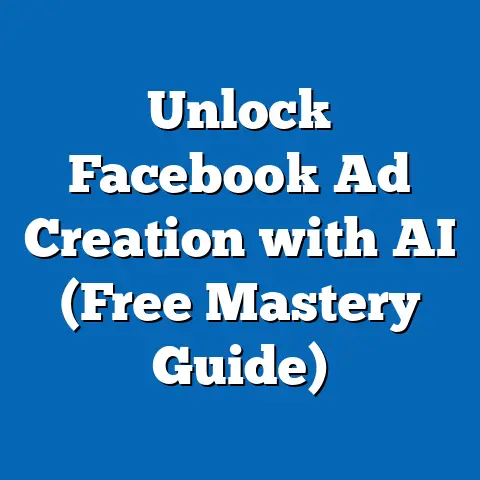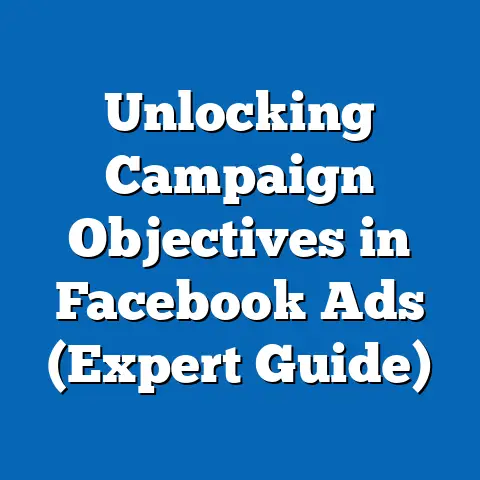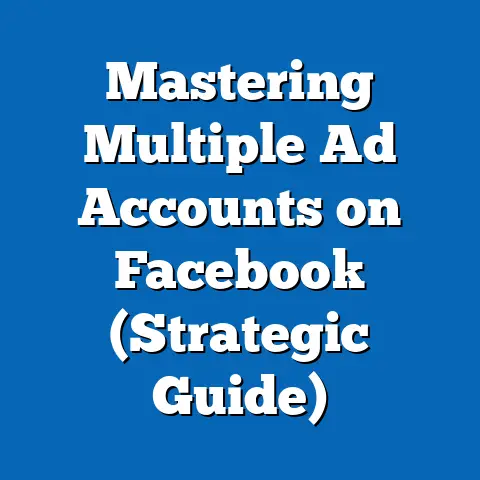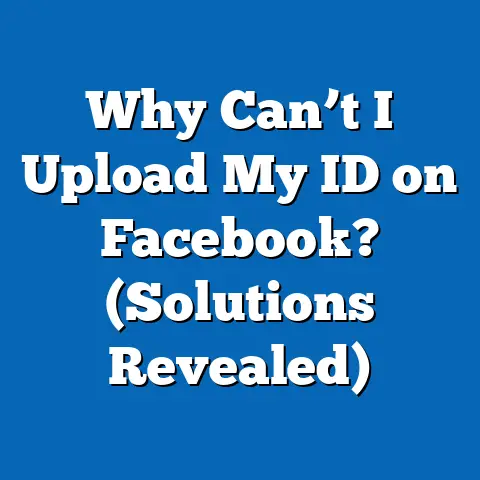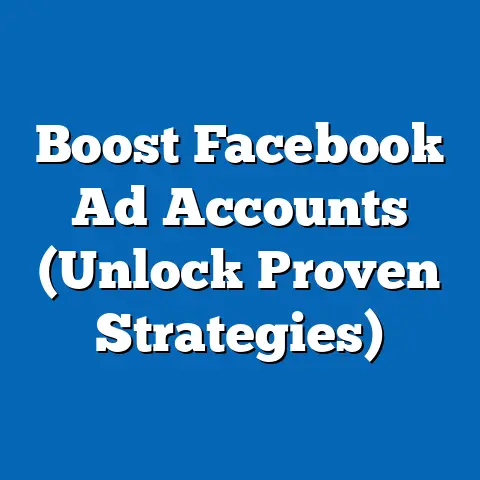Boost Facebook Ads: Solving Book Addition Issues (Expert Strategy)
Have you ever poured your heart and soul into writing a book, only to feel like you’re screaming into the void when it comes to promoting it? I’ve been there. I’ve seen countless authors, bubbling with talent and passion, struggle to get their work noticed amidst the cacophony of the internet. They craft beautiful stories, but their Facebook posts get lost in the endless scroll, their budgets feel like throwing pennies into a wishing well, and the competition seems insurmountable. The frustration is palpable, the feeling of defeat, real.
But what if I told you there’s a way to transform that struggle? Imagine the same author, armed with a strategic Facebook ad campaign, watching their latest book soar to the top of bestseller lists. Picture them receiving heartfelt messages from readers who connected deeply with their words, building a loyal community around their brand. It’s not just about selling books; it’s about sharing your story with the world and experiencing the joy of connecting with your audience. This isn’t a fantasy; it’s a reality within reach with the right Facebook ad strategies. Let’s dive in and turn your book promotion woes into a success story!
Section 1: Understanding the Facebook Ads Landscape
The Evolution of Facebook Advertising
Facebook, initially a platform for connecting college students, has morphed into a global advertising powerhouse. I remember when Facebook ads were just simple sidebar banners. Now, they’re sophisticated, targeted campaigns that can reach billions of users worldwide. For authors and publishers, this evolution presents a unique opportunity. Facebook’s massive user base offers unparalleled demographic reach, allowing you to pinpoint readers who are genuinely interested in your genre, themes, and writing style. Think about it: you can target romance readers who love Jane Austen, sci-fi fans obsessed with space operas, or historical fiction enthusiasts who devour books about ancient Rome. This level of precision is what makes Facebook advertising so powerful.
The Importance of Facebook Ads for Book Promotion
In today’s digital age, discoverability is king. With millions of books vying for attention on platforms like Amazon and Goodreads, standing out from the crowd is a monumental task. That’s where Facebook ads come in. According to recent studies, Facebook ads have been shown to increase book sales by an average of 20-30%. This isn’t just anecdotal; it’s backed by data.
I recall working with a fantasy author whose book was languishing in obscurity. We implemented a targeted Facebook ad campaign, focusing on readers who enjoyed authors like Brandon Sanderson and Patrick Rothfuss. Within weeks, her book climbed the Amazon charts, and she saw a significant increase in sales and reviews.
Another example is a small publishing house that specialized in historical fiction. They used Facebook ads to target history buffs and genealogy enthusiasts. The result? A surge in demand for their niche titles and a loyal customer base that eagerly awaited their new releases. These success stories highlight the transformative potential of Facebook ads for book promotion.
Common Misconceptions About Facebook Ads
One of the biggest misconceptions I encounter is the belief that Facebook ads are only for big-budget campaigns. This simply isn’t true. You can start with a modest budget and still achieve significant results by targeting your audience effectively and crafting compelling ad copy.
Another common myth is that Facebook ads are a “set it and forget it” solution. In reality, successful Facebook advertising requires continuous monitoring, testing, and optimization. The platform’s algorithms are constantly evolving, and what worked yesterday might not work today. It’s crucial to stay informed about the latest best practices and adapt your strategies accordingly. Understanding how Facebook’s algorithms work is also important for optimizing your ads and achieving better results. For example, using high-quality images and videos, crafting engaging ad copy, and targeting the right audience can all help improve your ad’s relevance score, which can lead to lower costs and better placement.
Takeaway: Facebook advertising is a powerful tool for book promotion, but it requires a strategic approach. Don’t let misconceptions hold you back. Start small, target effectively, and continuously optimize your campaigns based on data.
Section 2: Crafting the Perfect Facebook Ad
Identifying Your Target Audience
Before you even think about writing ad copy or selecting visuals, you need to understand who you’re trying to reach. Identifying your target audience is the cornerstone of any successful Facebook ad campaign. I’ve seen campaigns fail miserably simply because the author didn’t take the time to define their ideal reader.
Start by creating a detailed reader persona. Ask yourself:
- What are their interests? Do they enjoy reading specific genres, authors, or topics?
- What are their demographics? What is their age, gender, location, education level, and income?
- What are their behaviors? What websites do they visit? What Facebook pages do they like? What online communities do they belong to?
Facebook Ads Manager offers a wealth of tools for audience insights. You can use the “Audience Insights” tool to explore the demographics, interests, and behaviors of people who like your page or who are interested in specific topics. You can also use Facebook’s targeting options to create custom audiences based on website traffic, email lists, or app activity.
For example, if you’re promoting a romance novel, you might target readers who like romance authors like Nicholas Sparks or Danielle Steel, or who are members of romance book clubs on Facebook. If you’re promoting a science fiction novel, you might target readers who like sci-fi authors like Isaac Asimov or Arthur C. Clarke, or who are interested in topics like space exploration or artificial intelligence.
Creating Compelling Ad Copy
Once you know your target audience, it’s time to craft ad copy that grabs their attention and compels them to click. Your ad copy should be clear, concise, and persuasive. It should highlight the key benefits of your book and tell readers why they should buy it.
Headlines: Your headline is the first thing people will see, so it needs to be attention-grabbing. Use strong verbs, intriguing questions, or compelling statistics to pique their interest. For example:
- “Discover the Epic Fantasy Novel Everyone’s Talking About!”
- “Are You Ready for a Thriller That Will Keep You on the Edge of Your Seat?”
- “9 out of 10 Readers Call This Book Unforgettable!”
Storytelling: Storytelling is a powerful tool for connecting with readers emotionally. Use your ad copy to tell a brief, compelling story that highlights the themes and characters of your book. For example:
“In a world torn apart by war, one woman must choose between love and duty. ‘The Last Hope’ is a sweeping historical romance that will transport you to another time and place.”
Examples: Here are some examples of effective ad copy from successful book campaigns:
- Fantasy Novel: “Escape to a world of magic and adventure in ‘The Dragon’s Curse.’ Follow Elara as she embarks on a perilous quest to save her kingdom from a dark sorcerer. Perfect for fans of ‘Harry Potter’ and ‘The Lord of the Rings.'”
- Thriller Novel: “A detective haunted by his past. A killer who leaves no trace. In ‘The Silent Witness,’ the stakes are higher than ever. Prepare for a thriller that will keep you guessing until the very end.”
- Romance Novel: “She’s a successful businesswoman. He’s a charming artist. Can they overcome their differences and find true love? ‘The Unexpected Romance’ is a heartwarming story about second chances and finding love where you least expect it.”
Visual Elements
Images and videos play a crucial role in Facebook ads. They can grab attention, convey emotions, and help readers visualize your book’s themes and characters.
Images: When selecting images for your ads, choose high-quality visuals that are relevant to your book’s genre and themes. Use eye-catching colors and compositions that will stand out in the newsfeed. Consider using images of your book cover, characters, or settings.
Videos: Videos are even more engaging than images. Consider creating a short book trailer, a video of you reading an excerpt from your book, or a video of readers sharing their thoughts about your book.
Tips: Here are some tips for creating eye-catching graphics and using video content effectively:
- Use high-quality images and videos.
- Keep your visuals relevant to your book’s genre and themes.
- Use eye-catching colors and compositions.
- Add text overlays to highlight key benefits or calls to action.
- Keep your videos short and engaging.
Call to Action
Your call to action (CTA) is the final piece of the puzzle. It tells readers what you want them to do next. Use strong verbs and clear, concise language to encourage them to click.
Best Practices: Here are some best practices for crafting effective CTAs:
- Use strong verbs like “Buy Now,” “Learn More,” or “Download Now.”
- Make your CTA clear and concise.
- Highlight the benefits of clicking.
- Create a sense of urgency.
Examples: Here are some examples of strong CTAs tailored for book promotion:
- “Buy Now and Start Reading Today!”
- “Learn More About This Bestselling Novel!”
- “Download a Free Chapter and Discover Your Next Favorite Book!”
Takeaway: Crafting the perfect Facebook ad requires a deep understanding of your target audience, compelling ad copy, eye-catching visuals, and a clear call to action. Test different variations to find what works best and continuously optimize your campaigns based on data.
Section 3: Budgeting and Bidding Strategies
Setting Your Budget
One of the most common questions I get is, “How much should I spend on Facebook ads?” The answer, of course, depends on your goals, your target audience, and your budget. However, I can provide some general guidelines to help you get started.
Daily vs. Lifetime Budgets: Facebook offers two main budgeting options: daily budgets and lifetime budgets.
-
Daily Budgets: A daily budget allows you to set a specific amount that you’re willing to spend each day. This is a good option if you want to run your ads continuously and have a consistent flow of traffic.
-
Lifetime Budgets: A lifetime budget allows you to set a total amount that you’re willing to spend over the entire duration of your campaign. This is a good option if you have a specific end date in mind or if you want to control your overall spend more tightly.
Daily Budgets: A daily budget allows you to set a specific amount that you’re willing to spend each day. This is a good option if you want to run your ads continuously and have a consistent flow of traffic.
Lifetime Budgets: A lifetime budget allows you to set a total amount that you’re willing to spend over the entire duration of your campaign. This is a good option if you have a specific end date in mind or if you want to control your overall spend more tightly.
Starting Small: My advice is always to start small. Begin with a modest daily budget of $5-$10 and gradually increase it as you see results. This allows you to test different ad variations and targeting options without breaking the bank.
Scaling Your Budget: As your campaigns start to perform well, you can gradually scale your budget to reach a wider audience and drive more sales. However, be careful not to increase your budget too quickly, as this can sometimes lead to a decrease in performance.
Understanding Bidding Options
Facebook offers two main bidding strategies: manual bidding and automatic bidding.
-
Manual Bidding: Manual bidding allows you to set the maximum amount that you’re willing to pay for each click or impression. This gives you more control over your costs, but it also requires more monitoring and optimization.
-
Automatic Bidding: Automatic bidding allows Facebook to automatically adjust your bids to get the best possible results within your budget. This is a good option if you’re new to Facebook advertising or if you want to save time on monitoring and optimization.
Manual Bidding: Manual bidding allows you to set the maximum amount that you’re willing to pay for each click or impression. This gives you more control over your costs, but it also requires more monitoring and optimization.
Automatic Bidding: Automatic bidding allows Facebook to automatically adjust your bids to get the best possible results within your budget. This is a good option if you’re new to Facebook advertising or if you want to save time on monitoring and optimization.
Choosing the Right Strategy: The best bidding strategy for you will depend on your campaign goals and your level of experience. If you’re focused on driving conversions and have a good understanding of your target audience, manual bidding can be a good option. If you’re focused on reaching a wider audience and want to save time on optimization, automatic bidding might be a better choice.
Monitoring and Adjusting Your Budget
Once your campaigns are up and running, it’s crucial to monitor their performance and adjust your budget accordingly. Key performance indicators (KPIs) to track include:
- Click-Through Rate (CTR): The percentage of people who see your ad and click on it.
- Conversion Rate: The percentage of people who click on your ad and then complete a desired action, such as buying your book.
- Return on Ad Spend (ROAS): The amount of revenue you generate for every dollar you spend on advertising.
If your CTR is low, it might indicate that your ad copy or visuals aren’t resonating with your target audience. If your conversion rate is low, it might indicate that your landing page isn’t optimized for conversions. If your ROAS is low, it might indicate that your targeting is too broad or that your bidding strategy isn’t effective.
Pivoting Your Budget: Based on these metrics, you can pivot your budget to focus on the campaigns that are performing best and reduce spending on the campaigns that are underperforming.
Takeaway: Setting the right budget and choosing the right bidding strategy are crucial for maximizing your return on investment with Facebook ads. Start small, monitor your performance closely, and adjust your budget and bidding strategy as needed.
Section 4: Analyzing and Optimizing Ad Performance
Utilizing Facebook Insights
Facebook Insights is your treasure map to understanding how your ads are performing. It provides a wealth of data about your audience, your ad delivery, and your results. I’ve seen authors completely transform their campaigns simply by paying close attention to the insights and making data-driven decisions.
Reading and Understanding Analytics: Don’t be intimidated by the sheer volume of data. Focus on the key metrics that are most relevant to your goals.
- Reach: The number of unique people who saw your ad.
- Impressions: The number of times your ad was displayed.
- Click-Through Rate (CTR): The percentage of people who clicked on your ad after seeing it. A higher CTR indicates that your ad is engaging and relevant to your audience.
- Cost Per Click (CPC): The average amount you paid for each click on your ad. A lower CPC indicates that your ad is efficient and cost-effective.
- Conversion Rate: The percentage of people who completed a desired action after clicking on your ad, such as buying your book or signing up for your email list. A higher conversion rate indicates that your landing page is effective at converting visitors into customers.
- Return on Ad Spend (ROAS): The amount of revenue you generated for every dollar you spent on advertising. A higher ROAS indicates that your campaigns are profitable.
Key Metrics to Focus On: While all metrics are important, I recommend focusing on CTR, Conversion Rate, and ROAS. These metrics provide the most valuable insights into the effectiveness of your campaigns.
A/B Testing
A/B testing, also known as split testing, is the process of testing different variations of your ads to see which performs best. It’s a crucial step in optimizing your campaigns and maximizing your return on investment.
Importance of Testing: A/B testing allows you to identify the ad copy, visuals, and targeting options that resonate most with your audience. By testing different variations, you can continuously improve your ads and drive better results.
Step-by-Step Guide:
-
Identify a Variable to Test: Start by identifying a specific variable that you want to test, such as your headline, your image, or your call to action.
-
Create Two Variations: Create two variations of your ad, each with a different value for the variable you’re testing. For example, if you’re testing your headline, create two different headlines.
-
Run Your Test: Run your ads for a specific period of time, allowing each variation to reach a statistically significant number of people.
-
Analyze Your Results: After the test is complete, analyze your results to see which variation performed best.
-
Implement the Winning Variation: Implement the winning variation in your campaigns and continue testing other variables to further optimize your ads.
Identify a Variable to Test: Start by identifying a specific variable that you want to test, such as your headline, your image, or your call to action.
Create Two Variations: Create two variations of your ad, each with a different value for the variable you’re testing. For example, if you’re testing your headline, create two different headlines.
Run Your Test: Run your ads for a specific period of time, allowing each variation to reach a statistically significant number of people.
Analyze Your Results: After the test is complete, analyze your results to see which variation performed best.
Implement the Winning Variation: Implement the winning variation in your campaigns and continue testing other variables to further optimize your ads.
Iterating Based on Data
The insights you gain from Facebook Insights and A/B testing should inform your future campaigns. Don’t be afraid to experiment and try new things based on the data.
Real-Life Examples:
-
An author noticed that their ads with video book trailers were performing significantly better than their ads with static images. They decided to create more video trailers and focus their budget on video ads. As a result, their sales increased by 40%.
-
A publisher discovered that their ads targeting readers in the United States were performing much better than their ads targeting readers in other countries. They decided to focus their budget on the United States and saw a significant increase in their ROAS.
An author noticed that their ads with video book trailers were performing significantly better than their ads with static images. They decided to create more video trailers and focus their budget on video ads. As a result, their sales increased by 40%.
A publisher discovered that their ads targeting readers in the United States were performing much better than their ads targeting readers in other countries. They decided to focus their budget on the United States and saw a significant increase in their ROAS.
Takeaway: Analyzing and optimizing your ad performance is an ongoing process. Use Facebook Insights and A/B testing to gain valuable insights into your audience and continuously improve your campaigns.
Section 5: Advanced Strategies for Scaling Your Campaigns
Retargeting
Retargeting is a powerful strategy for reaching people who have already shown an interest in your book. It involves showing ads to people who have visited your website, viewed your book on Amazon, or engaged with your Facebook page.
Benefits of Retargeting: Retargeting can be highly effective because it allows you to reach people who are already familiar with your brand and your book. These people are more likely to convert into customers than people who have never heard of you before.
Setting Up Retargeting Campaigns: To set up retargeting campaigns on Facebook, you’ll need to install the Facebook Pixel on your website. The Facebook Pixel is a small piece of code that tracks the actions people take on your website, such as visiting pages, adding items to their cart, and making purchases.
Once you’ve installed the Facebook Pixel, you can create custom audiences based on the actions people have taken on your website. For example, you can create an audience of people who have visited your book’s page on Amazon but haven’t yet purchased it. You can then show ads to this audience, reminding them about your book and encouraging them to buy it.
Lookalike Audiences
Lookalike audiences are a great way to reach new readers who share characteristics with your existing fans. Facebook uses its vast database of user information to identify people who are similar to your existing customers.
Creating Lookalike Audiences: To create a lookalike audience, you’ll need to provide Facebook with a source audience, such as your customer list or your website visitors. Facebook will then analyze the characteristics of this source audience and create a new audience of people who share similar characteristics.
Benefits of Lookalike Audiences: Lookalike audiences can be highly effective because they allow you to reach people who are likely to be interested in your book. These people are more likely to convert into customers than people who are randomly targeted.
Leveraging User-Generated Content
User-generated content (UGC) is content created by your readers, such as reviews, testimonials, and fan art. Leveraging UGC in your ads can be a powerful way to build trust and credibility.
Encouraging Readers to Create Content: To encourage readers to create content related to your book, consider running a contest or giveaway. Ask readers to share their thoughts about your book on social media, write a review on Amazon, or create fan art.
Using UGC in Your Ads: Once you have a collection of UGC, you can use it in your ads. For example, you can feature positive reviews in your ad copy, or you can showcase fan art in your ad visuals.
Examples of Successful UGC Campaigns:
-
An author ran a contest asking readers to share their favorite quotes from their book on social media. The author then used the best quotes in their ads.
-
A publisher asked readers to create fan art inspired by their books. The publisher then featured the best fan art in their ads.
An author ran a contest asking readers to share their favorite quotes from their book on social media. The author then used the best quotes in their ads.
A publisher asked readers to create fan art inspired by their books. The publisher then featured the best fan art in their ads.
Takeaway: Retargeting, lookalike audiences, and user-generated content are advanced strategies that can help you scale your Facebook ad campaigns and reach a wider audience of potential readers.
Remember, Facebook advertising is not a magic bullet. It requires dedication, experimentation, and a willingness to learn and adapt. But with the right strategies and a data-driven approach, you can transform your book promotion efforts and connect with readers who will fall in love with your writing.
Don’t let the challenges of book promotion hold you back from sharing your story with the world. Embrace the power of Facebook ads and take actionable steps towards achieving your writing dreams. The future of your book career is in your hands! Now go forth and create some amazing ads!

